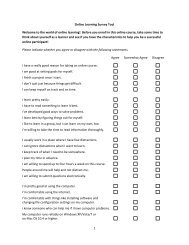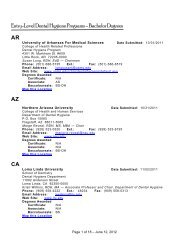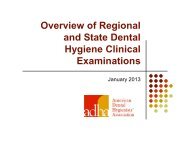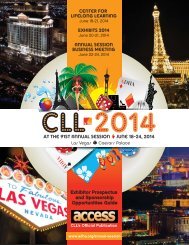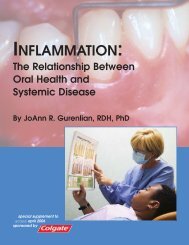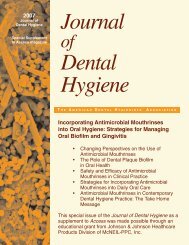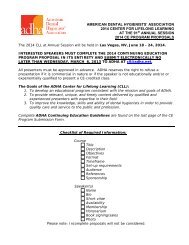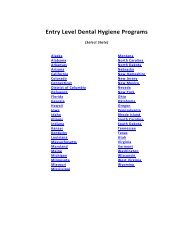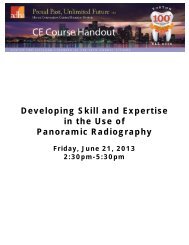Toothbrushing Behavior Change - American Dental Hygienists ...
Toothbrushing Behavior Change - American Dental Hygienists ...
Toothbrushing Behavior Change - American Dental Hygienists ...
Create successful ePaper yourself
Turn your PDF publications into a flip-book with our unique Google optimized e-Paper software.
SPECIAL SUPPLEMENTARY ISSUE—SEP-OCT 2010<br />
Using Brief<br />
Motivational<br />
Interviewing<br />
to Sustain<br />
<strong>Toothbrushing</strong><br />
<strong>Behavior</strong><br />
<strong>Change</strong><br />
By Kimberly Krust Bray, RDH, MS<br />
Developed in collaboration with<br />
and sponsored by GlaxoSmithKline<br />
Consumer Healthcare
A recent study conducted by Gallagher et al looking at the effect<br />
of brushing times and dentifrice on plaque removal concluded<br />
that oral health care professionals should reinforce efforts to<br />
persuade patients to brush for longer periods of time, as increasing<br />
brushing time to the consensus minimum of two minutes<br />
increases plaque removal to an extent likely to provide clinically<br />
significant oral health benefits. 1 These results are consistent with<br />
previous findings that demonstrate patients typically overestimate<br />
their adherence to the two-minute brushing recommendation.<br />
This discrepancy is well documented in data by Saxer et al<br />
as presented in Table I. 2<br />
Table I. Brushing time in seconds 2<br />
Actual<br />
Estimated<br />
68.8 148.1<br />
73.7 128.2<br />
83.5 146.8<br />
80.1 141.7<br />
65.2 133.4<br />
There is currently a discrepancy between what<br />
professionals believe regarding the length of time<br />
their patients are brushing and the actual practice<br />
of their patients.<br />
Further studies examining tooth brushing time demonstrate<br />
that the use of powered toothbrushes with timing or pacing<br />
devices further improved overall time spent brushing compared<br />
to manual brushing alone. Dentino et al reported that while only<br />
17 percent of manual toothbrush users meet the two-minute<br />
brushing time recommendation, 66 percent of powered toothbrush<br />
users were two-minute compliant. 3 These results suggest<br />
that timing devices provide meaningful feedback to patients. The<br />
new evidence by Gallagher et al substantiates the importance<br />
of compliance with recommendations for adequate duration by<br />
clearly demonstrating improved oral health outcomes associated<br />
with ideal brushing times. 1 Specifically, brushing for 120 seconds<br />
removed 26 percent more plaque than brushing for 45 seconds.<br />
Better plaque removal was seen with increased brushing times.<br />
Brushing for 180 seconds removed 55 percent more plaque than<br />
brushing for 30 seconds. 1<br />
There is currently a discrepancy between what professionals<br />
believe regarding the length of time their patients are brushing<br />
and the actual practice of their patients. This survey looked at<br />
the tooth brushing times of patients as assessed by professionals<br />
to see if there are perception discrepancies. A six-question<br />
electronic survey was sent out to a convenience sample of dental<br />
hygienists via ADHA Update. There were 543 total respondents<br />
to the survey with 496 identifying as practicing clinical hygienist.<br />
The results from the practicing hygienists are as follows:<br />
Q1. In your opinion, how much does the duration of brushing<br />
affect the amount of plaque that is removed?<br />
Answer options<br />
Response percent<br />
A lot 82.4<br />
Somewhat 17.3<br />
Not at all 0.2<br />
Q2. How often do you speak with your patients about brushing<br />
times?<br />
Answer options<br />
Response percent<br />
At every patient visit 77.4<br />
Yearly 16.9<br />
Only on the first visit 3.7<br />
Not at all 2.1<br />
Q3. What length of time do your patients typically report they<br />
spend brushing?<br />
Answer options<br />
Response percent<br />
30 sec 12.1<br />
1 min 42.6<br />
2 min 32.7<br />
3 min 3.5<br />
N/A 9.1<br />
Q4. In your opinion, what is the most effective brushing<br />
time?<br />
Answer options<br />
30 sec 0.0<br />
1 min 2.5<br />
2 min 69.4<br />
3 min 28.1<br />
Q5. Are you aware of the Gallagher study that addresses effective<br />
brushing time?<br />
Answer options<br />
Response percent<br />
Yes 6.9<br />
No 93.1<br />
This study was funded by GlaxoSmithKline Consumer Healthcare.<br />
Brushing twice daily for two minutes and flossing once daily<br />
is a singularly consistent recommendation made by oral health<br />
providers. Yet despite its relative simplicity, patients often fail to<br />
adhere to this recommendation. This lack of adherence to selfcare<br />
and treatment recommendations is not atypical. Studies on<br />
adherence to health professionals’ recommendations have shown<br />
that approximately 30 percent to 60 percent of health information<br />
provided in the clinician/patient encounter is forgotten within<br />
an hour, and 50 percent of health recommendations are not followed.<br />
4 Oral health providers typically learn and approach patient<br />
encounters in a persuasive authority manner, offering knowledge<br />
and prescriptive strategies to persuade the patient to make the<br />
required behavior change. Professional advice and recommendations<br />
are typically most successful in clients who are already prepared<br />
for change. For those with ambivalence or frank resistance<br />
to change, improved adherence has been demonstrated when a<br />
more behavioral, less cognitive focus is used. In all cases, desire,<br />
ability and reasons for change must come from the patient. Daily<br />
effective dental plaque removal, adherence to regular professional<br />
periodontal maintenance visits, healthy dietary and lifestyle<br />
habits are adherence issues dental hygienists often address in<br />
their patient encounters. A number of well-established health<br />
psychology models provide alternative approaches to elicit-<br />
2 Supplement to Access—September-October 2010
Table II. Elicit-Provide-Elicit Approach<br />
Open-ended questions Affirmations Reflections Summaries<br />
What is your understanding of<br />
how brushing time affects your<br />
gum health?<br />
What would the benefits be of<br />
brushing longer?<br />
I commend you for your commitment<br />
to brushing at least twice<br />
daily.<br />
I know it is easy to cut your<br />
brushing time short, especially<br />
when you have such a busy<br />
schedule.<br />
Generally, you are not sure how<br />
long you spend brushing your<br />
teeth, but a powered toothbrush<br />
with a built in timing device<br />
might help you meet two-minute<br />
brushing goals.<br />
ing behavior change. Motivational interviewing (MI) is a wellaccepted<br />
strategy aimed at behavior change shown to positively<br />
affect health behavior change related to smoking, drug addiction,<br />
exercise, weight reduction, diabetes management, medication<br />
adherence, condom use and oral health. 5<br />
MI is a directive, client-centered counseling style for eliciting<br />
behavior change by helping clients to explore and resolve<br />
ambivalence. 6 It recognizes and accounts for the fact that direct<br />
persuasion is often ineffective at sustaining behavior change.<br />
Motivation and confidence to make a change, as well as recognition<br />
of the change as important, are elicited from the client<br />
rather than prescribed by the dentist or dental hygienists. The<br />
specific strategies of MI still allow the clinician to be directive in<br />
helping a patient elicit, clarify and resolve ambivalence. This is<br />
accomplished by enabling the patient to identify pros and cons<br />
associated with a particular behavior pattern and determine<br />
what action, if any, to take. The decision comes from within the<br />
patient, not the counselor, allowing the patient to have complete<br />
autonomy in the decision-making process. 5,7<br />
Applications in dentistry demonstrate that a brief MI session<br />
before or in conjunction with the dental education session can<br />
lead to improved knowledge and oral hygiene relative to traditional<br />
education alone. Weinstein et al compared the effect of a<br />
MI counseling visit to standard health education practices with<br />
parents of children susceptible to early childhood caries. After<br />
two years, children in the MI group exhibited significantly less<br />
new caries (35.2 percent) than those in the control group (52<br />
percent). The study indicated that, as a result of MI, there was a<br />
higher incidence of fluoride varnish application appointments in<br />
the MI group as compared to the control. 8,9<br />
Further, improvement in plaque, autonomous regulation and<br />
oral health knowledge were improved significantly more following<br />
a 15- to 20-minute session of brief MI in a population with severe<br />
mental illness than those who received only oral health education.<br />
While both groups showed reductions in plaque from baseline to<br />
four weeks, only the MI group sustained significant reductions in<br />
plaques from the fourth to eighth week of the study. 10<br />
<strong>Dental</strong> and dental hygiene students alike have been successfully<br />
trained in MI. 11,12 This review of MI counseling spirit and<br />
strategies will focus on how this approach might be used to elicit<br />
oral health behavior change within the dental counseling atmosphere.<br />
The key components of brief MI that can be applied for<br />
the delivery of oral health information and advice are: Ask Permission,<br />
Elicit-Provide-Elicit, Sort Options and Obtain Commitment.<br />
Ask Permission<br />
Asking permission to discuss or share strategic information<br />
is an integral first step in establishing the collaborative spirit of<br />
MI. It quickly and efficiently demonstrates respect for the client’s<br />
autonomy and freedom of choice/consequences regarding their<br />
behavior. In the instance of exploring the adequacy of a patient’s<br />
time spent brushing, the clinician might ask, “Would it be okay<br />
if we spent a few minutes discussing the tooth brushing instructions<br />
we introduced at your last visit?”<br />
Elicit-Provide-Elicit<br />
It is human nature to be more accepting of those ideas or<br />
reasons we offer than to accept those offered by others. This<br />
three-phase process begins by asking the client what they<br />
already know or are interested in knowing about an oral health<br />
area of interest. “What do you know about the risks associated<br />
with inadequate tooth brushing time?” This simple opening respects<br />
the patient’s skills and knowledge, and avoids telling them<br />
something they already know. The practitioner then provides<br />
only the information the client needs after the client tells what<br />
they already know or is interested in knowing. Lastly, the clinician<br />
asks the client’s view on what is offered.<br />
It is human nature to be more accepting of those<br />
ideas or reasons we offer than to accept those<br />
offered by others.<br />
The Elicit-Provide-Elicit approach is achieved through the use<br />
of open-ended questions, affirmations, reflections and summaries<br />
(Table II). Open-ended questions, those requiring more than<br />
a yes/no or short answer, stimulate the client to do most of the<br />
talking. While short-answer or closed-ended questions may be<br />
appropriate at times, their use should be limited. The clinician<br />
assumes the role of an active listener reflecting back what the<br />
patient has said. Reflective listening is an important and challenging<br />
skill to develop. Skillful reflections are not limited to simply<br />
repeating what the client has said, but attempt to discover<br />
underlying meaning in what is elicited. They can also serve as an<br />
opportunity to express empathy.<br />
Cues elicited from the client help direct the way that further<br />
information is provided. This exchange may require the clinician<br />
to resist the temptation to prescribe a solution to solve the<br />
patient’s problem, often referred to as the “righting reflex.” The<br />
righting reflex is to be avoided, as it often increases resistance,<br />
thereby decreasing the probability of behavior change. Certainly,<br />
as professionals, we do not let clients select unhealthy or<br />
risky actions without expressing our concern for an undesirable<br />
plan. Likewise, misperceptions can and should be corrected. For<br />
example, “The client states, there is nothing wrong with bleeding<br />
gums. It’s normal for gums to bleed sometimes.” The clinician<br />
can present alternative information. “It’s interesting how many<br />
people have that same idea. Actually, there is research showing<br />
that bleeding gums are a sign of inflammation that can worsen<br />
and lead to tooth loss. Would you be interested in hearing about<br />
that?” Finally, summarizing periodically throughout a discussion<br />
to reinforce what the patient has said will confirm that the coun-<br />
Supplement to Access—September-October 2010 3
selor is listening and allows the patient to hear their words again.<br />
Since giving advice is such an integral component of the dental<br />
hygienist’s job, the following points more thoroughly review the<br />
basic concepts for information sharing.<br />
Basic concepts of giving advice for sustainable behavior change: 13<br />
• Offer information, don’t impose it<br />
• Find out if patients want the information before you give<br />
it<br />
• Ask permission, especially when the information was not<br />
elicited<br />
• Provide information in the context of other clients (I<br />
don’t know if this will make sense to you, but as I have<br />
seen in my interaction with clients like yourself, they<br />
have found…”)<br />
• Give clients permission to disagree with you<br />
• Use client statements to mirror or reflect what they said<br />
so they can observe their own conjectures<br />
• Give information that is factually or evidence based,<br />
rather than just opinion<br />
• Invite clients to decide what the information means for<br />
them (“What are your thoughts about this?)<br />
• Remember your patient is a person, not an information<br />
receptacle. It is easy to feel there is so much information<br />
clients must know that we as providers need to supply<br />
rather quickly. However, it is not realistic that they can<br />
process all this information at once<br />
Initial understanding derived from open-ended questioning<br />
and reflective listening provides the clinician with the basis for<br />
eliciting personal discrepancies held by the patient. One approach<br />
that can be used to explore the level of importance, confidence<br />
and/or motivation for engaging in a new behavior is the use of<br />
rulers. For instance, the clinician can ask, “On a scale of 1 to 10,<br />
with 10 being most important, how important is your oral health<br />
to you?” Once the patient identifies their self-rated importance,<br />
the clinician can further clarify by asking, “What would it take for<br />
you to increase the importance 2 or 3 additional levels?” Inconsistencies<br />
between the current health behaviors and goals/preferences<br />
create a rationale for change.<br />
Ultimately, an integral objective of MI is to elicit commitment<br />
statements (change talk). It is quite powerful and effective when<br />
patients hear themselves suggest a change in behavior. This<br />
increases their commitment to what they are saying and reinforces<br />
autonomy. The task of the clinician is to evoke, facilitate<br />
and strengthen self-motivated change talk rather than attempting<br />
externally to drive the change. 5<br />
Provide Options and Obtain Commitment<br />
incremental goal or permission to keep communication open. For<br />
example, “Circumstances may change, so can we agree to leave<br />
the door open on this one?”<br />
The purpose of this article was to introduce these concepts to<br />
clinical dental hygienists in the context of oral hygiene education/<br />
instruction. To gain additional knowledge and skills in MI, clinicians<br />
are encouraged to more thoroughly explore this exciting approach<br />
through training programs. As MI use emerges in dentistry, such<br />
training within our discipline may not be readily available. Fidelity<br />
in the method of MI training is also a concern. Not unlike mastering<br />
other new skills, successful adoption and use of MI requires<br />
practice, ideally with supervision and coaching. 14 Such mentoring<br />
may also currently be limited due to a lack of access to those in<br />
the discipline with such experience. Fortunately, the Motivational<br />
Interviewing Network of Trainers (MINT) provides a variety of<br />
useful training materials and nationwide course offerings to help<br />
practitioners learn MI (see www.motivationalinterview.org).<br />
References<br />
1. Gallagher A, Sowinski J, Bowman J et al. The effect of brushing time and<br />
dentifrice on dental plaque removal in vivo. J Dent Hyg. 2009; 83: 111-6.<br />
2. Saxer UP, Barbakow J, Yankell SL. New studies on actual and estimated<br />
toothbrushing times and dentifrice use. J Clin Dent. 1998; 9:49-51.<br />
3. Dentino AR, Derderian G, Wolf MA, et al. Six month comparison of powered<br />
vs manual tooth brushing for safety and efficacy in the absence of professional<br />
instruction in mechanical plaque control. J Periodontol 2002; 73: 770-8.<br />
4. DiMatteo MR, Giordani PJ, Lepper HS, Croghan TW. Patient adherence and<br />
medical treatment outcomes: a meta-analysis. Med Care. 2002; 40: 794-811.<br />
5. Williams K, Bray K. Increasing patient engagement in care: motivational<br />
interviewing. Access. 2009; 23 (5): 36-9.<br />
6. Miller W, Rollnick S. Motivational interviewing, 2nd ed. New York: Guilford<br />
Press; 2002.<br />
7. Williams K. Motivational interviewing: application to oral health behaviors. J<br />
Dent Hyg 2010; 84(1): 6-9.<br />
8. Weinstein P, Harrison R, Benton T. Motivating parents to prevent caries. J Am<br />
Dent Assoc. 2004; 135: 731-8.<br />
9. Weinstein P, Harris R, Benton T. Motivating mothers to prevent caries: confirming<br />
the beneficial effect of counseling. J Am Dent Assoc. 2006; 137(6): 789-93.<br />
10. Almomani F, Brown T, Williams KB, Catley D. Effects of oral health promotion<br />
program in people with mental illness. J Dent Res. 2009; 88(7): 648-2.<br />
11. Koerber A, Crawford J, O’Connell K. The effects of teaching dental students<br />
brief motivational interviewing for smoking-cessation counseling: a pilot<br />
study. J Dent Educ. 2003; 67:439-47.<br />
12. Croffoot C, Bray K, Black M, Koerber A. Evaluating the effects of coaching to<br />
improve motivational interviewing skills of dental hygiene students. J Dent<br />
Hyg. 2010; 84(2): 86-93.<br />
13. Rosengren DB. Building motivational interviewing skills, a practitioner workbook.<br />
New York: Guilford Press; 2009.<br />
14. Moyers T, Manuel J. A randomized trial investigating training in motivational<br />
interviewing for behavioral health providers. Behav Cognit Psychother. 2008;<br />
36: 149-62.<br />
Once again, it is important for the clinician to resist the temptation<br />
to offer a single simple solution. The approach should be<br />
more consistent with a brainstorming session, sorting a variety<br />
of potential options for what the patient would like to change and<br />
arriving at a plan. This can be guided by asking the patient what<br />
they feel could work for them based on their own past experience,<br />
the experience of others or conjecture. The clinician can<br />
direct the brainstorming by supplementing their ideas. Ultimately,<br />
the patient chooses with the clinician, affirming their freedom of<br />
choice and self-direction. When the clinician argues their point<br />
for the patient to change their behavior, it will create a situation<br />
where an ambivalent patient will defend the opposing argument<br />
and thus inhibit change. In the event the patient resists making<br />
a commitment to change, roll with the resistance by offering an<br />
Kimberly Krust Bray is professor and director<br />
for the Division of <strong>Dental</strong> Hygiene at the<br />
University of Missouri-Kansas City School<br />
of Dentistry. She holds a Master of Science<br />
in <strong>Dental</strong> Hygiene Education (1988) and<br />
a Bachelor of Science in <strong>Dental</strong> Hygiene<br />
(1986) from the University of Missouri-<br />
Kansas City and an Associate in Applied Science<br />
in <strong>Dental</strong> Hygiene from Sinclair Community<br />
College (1985). She has published<br />
and presented widely, received numerous<br />
prestigious honors and held leadership<br />
roles in many professional organizations.<br />
Research interests include product efficacy,<br />
ergonomics, motivational interviewing and<br />
alternative learning strategies.<br />
Developed in collaboration with and sponsored by GlaxoSmithKline Consumer Healthcare<br />
4 Supplement to Access—September-October 2010




